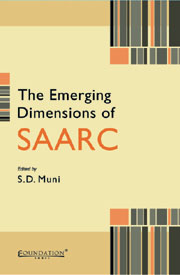Book contents
- Frontmatter
- Contents
- Preface
- List of Figures
- List of Tables
- 1 SAARC Prospects: The Changing Dimensions
- 2 SAARC and South Asian Economic Integration
- 3 Coping with the Emerging Challenges: Poverty and Food Security
- 4 SAARC Energy Cooperation: Energy Security and Environmental Challenges
- 5 Sub-Regional Cooperation under SAARC: An Economic Analysis
- 6 SAARC: Social Charter and Human Security
- 7 SAARC and the South Asian Security Architect
- 8 Fighting Terrorism through SAARC?
- 9 SAARC and the Evolving Asian Regionalism
- 10 Role of SAARC Observers: Members' Perspectives
- 11 Role of SAARC Observers: Observers' Perspectives
- 12 Concluding Remarks
- About the Contributors
- Index
4 - SAARC Energy Cooperation: Energy Security and Environmental Challenges
Published online by Cambridge University Press: 26 October 2011
- Frontmatter
- Contents
- Preface
- List of Figures
- List of Tables
- 1 SAARC Prospects: The Changing Dimensions
- 2 SAARC and South Asian Economic Integration
- 3 Coping with the Emerging Challenges: Poverty and Food Security
- 4 SAARC Energy Cooperation: Energy Security and Environmental Challenges
- 5 Sub-Regional Cooperation under SAARC: An Economic Analysis
- 6 SAARC: Social Charter and Human Security
- 7 SAARC and the South Asian Security Architect
- 8 Fighting Terrorism through SAARC?
- 9 SAARC and the Evolving Asian Regionalism
- 10 Role of SAARC Observers: Members' Perspectives
- 11 Role of SAARC Observers: Observers' Perspectives
- 12 Concluding Remarks
- About the Contributors
- Index
Summary
Introduction
With a population of approximately 1.6 billion, South Asia represents nearly 24 per cent of the world's total population spread over less than 4 per cent of the world's surface. South Asia is dominated by India from a demographic point of view, which alone has a population approximating 1.17 billion, along with two other densely populated countries in the region – Pakistan and Bangladesh, with populations of 164 and 159 million respectively in 2007. South Asia also includes countries with small populations such as Bhutan, with only 658,000 inhabitants and the Maldives with just 306,000. The demographic challenges confronting South Asia are those of developing countries faced with a major population increase. When South Asia tries to meet ambitious poverty reduction goals, their growing industrial, commercial and transport sectors and urban and middle-income consumers use energy at an unprecedented rate.
South Asia's strong economic growth has led to increase in the consumption of energy and thus increase in the demand for energy. Yet the prevailing impressive economic growth rate is constrained by significant shortages in energy supply in the region. Recent studies on energy requirements in South Asia reveal that India, Pakistan, Bangladesh, Sri Lanka and Afghanistan have energy demand surpassing their domestic supply, while Bhutan and Nepal have energy resources, hydropower in particular, far in excess of their domestic needs that can be traded within the region. Moreover, Bangladesh, India and Pakistan have potential for significant electricity and gas trade within South Asia.
- Type
- Chapter
- Information
- The Emerging Dimensions of SAARC , pp. 81 - 112Publisher: Foundation BooksPrint publication year: 2010



